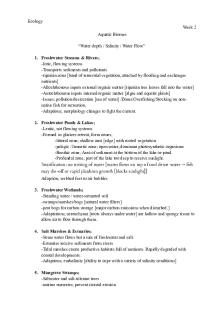Aquatic Biomes - week 2 - Lecture notes 2 PDF

| Title | Aquatic Biomes - week 2 - Lecture notes 2 |
|---|---|
| Author | Jemma Radford |
| Course | Ecology |
| Institution | University of Reading |
| Pages | 2 |
| File Size | 73 KB |
| File Type | |
| Total Downloads | 48 |
| Total Views | 145 |
Summary
Download Aquatic Biomes - week 2 - Lecture notes 2 PDF
Description
Ecology Week 2 Aquatic Biomes “Water depth / Salinity / Water Flow” 1. Freshwater Streams & Rivers; -Iotic, flowing systems -Transports sediments and pollutants -riparian zone [band of terrestrial vegetation, attached by flooding and exchanges nutrients] -Allochthonous inputs external organic matter [riparian tree leaves fall into the water] -Autochthonous inputs internal organic matter [algae and aquatic plants] -Issues; pollution/desiccation [use of water] /Dams/Overfishing/Stocking on nonnative fish for recreation. -Adaptions; morphology changes to fight the current. 2. Freshwater Ponds & Lakes; -Lentic, not flowing systems -Formed as glaciers retreat, form zones; -littoral zone; shallow area [edge] with rooted vegetation -pelagic / limnetic zone; open water, dominant photosynthetic organisms -Benthic zone; Area of sediment at the bottom of the lake or pond -Profundal zone; part of the lake too deep to receive sunlight. Stratification; no mixing of water [warm flows on top of cool dense water → fish may die-off or rapid plankton growth [blocks sunlight]] Adaption; webbed feet or air bubbles 3. Freshwater Wetlands; -Standing water / water-saturated soil -swamps/marshes/bogs [natural water filters] -peat bogs for carbon storage [major carbon emissions when disturbed.] -Adaptations; aerenchyma [roots always under water] are hollow and spongy tissue to allow air to flow through them. 4. Salt Marshes & Estuaries; -Some water flows but a mix of freshwater and salt. -Estuaries receive sediments from rivers -Tidal marshes create productive habitats full of nutrients. Rapidly degraded with coastal developments. -Adaptions; eurhalinity [ability to cope with a variety of salinity conditions] 5. Mangrove Swamps; -Saltwater and salt-tolerant trees -marine nurseries; prevent coastal erosion
Ecology Week 2 -Adaption; aerial roots [ group together to share O2] 6. Intertidal Zones; -land under the influence of the ocean/sea tides -species are adapted to changing conditions [flooded /dry] -shorebirds specialise in feeling here -Adaption; shells/anchors to prevent wave action 7. Coral Reefs; -underwater, warm, shallow -Coral & Algae mutualism, high biodiversity -Issue; coral bleaching due to higher sea temperatures Adaptations; maneuverability; laterally compressed bodies with fins to move quickly between the reefs. 8. Open Ocean; a. Neritic Zone; lowest tidal level to depths of 200m [region of high productivity. b. Oceanic Zone; beyond the neritic, sparse nutrients, production limited c. Photic Zone; top part of the ocean with light for photosynthesis d. Aphotic Zone; no light / very little production e. Benthic; sea floor -Adaptions; bioluminescence for vision -Issues; conservation is hard as the oceans are not owned or enforced....
Similar Free PDFs

Terrestrial & Aquatic Biomes Ch6
- 11 Pages

WEEK 2 - Lecture notes 2
- 5 Pages

Week 2 - Lecture notes 2
- 7 Pages

Week 2 Lecture Notes
- 5 Pages

Week Two - Lecture notes 2
- 9 Pages

Lecture Notes Week 2 1014CCJ
- 7 Pages

WEEK 2 ACCY112 - Lecture notes 2
- 3 Pages

NSE 13 week 2 - Lecture notes 2
- 5 Pages

NURS10016 - Week 2 - Lecture notes 2
- 22 Pages
Popular Institutions
- Tinajero National High School - Annex
- Politeknik Caltex Riau
- Yokohama City University
- SGT University
- University of Al-Qadisiyah
- Divine Word College of Vigan
- Techniek College Rotterdam
- Universidade de Santiago
- Universiti Teknologi MARA Cawangan Johor Kampus Pasir Gudang
- Poltekkes Kemenkes Yogyakarta
- Baguio City National High School
- Colegio san marcos
- preparatoria uno
- Centro de Bachillerato Tecnológico Industrial y de Servicios No. 107
- Dalian Maritime University
- Quang Trung Secondary School
- Colegio Tecnológico en Informática
- Corporación Regional de Educación Superior
- Grupo CEDVA
- Dar Al Uloom University
- Centro de Estudios Preuniversitarios de la Universidad Nacional de Ingeniería
- 上智大学
- Aakash International School, Nuna Majara
- San Felipe Neri Catholic School
- Kang Chiao International School - New Taipei City
- Misamis Occidental National High School
- Institución Educativa Escuela Normal Juan Ladrilleros
- Kolehiyo ng Pantukan
- Batanes State College
- Instituto Continental
- Sekolah Menengah Kejuruan Kesehatan Kaltara (Tarakan)
- Colegio de La Inmaculada Concepcion - Cebu






